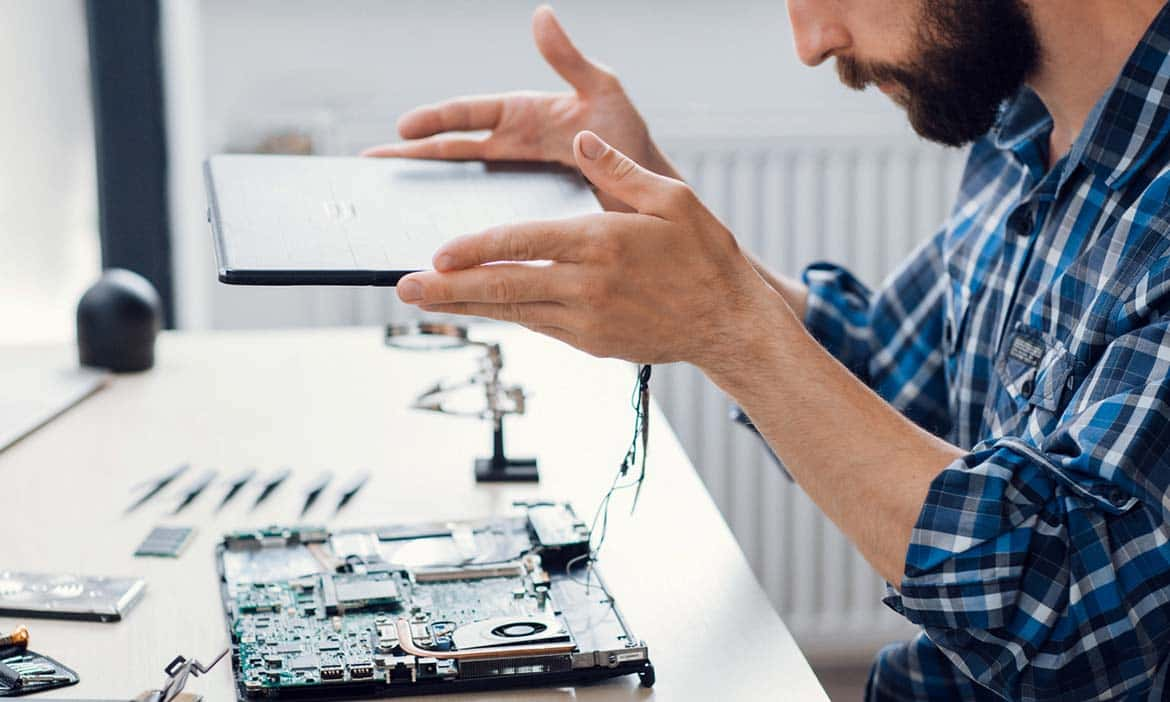
A deep dive into waste electrical and electronic equipment
How often do you buy or replace electronics or electrical items? What do you do with the old ones? Do you have a pile to get rid of? Perhaps a collection in a drawer or cupboard that you’ve been meaning to deal with?
Raw materials for electricals and electronics includes some high-value metals. Some are becoming scarce on land with demand also growing for more obscure ‘rare-earth elements’ with unique properties suited to digital innovations like screen technology. The deep sea bed and subsurface are a potential source of these required materials.
Electronic and electrical items are now integral to our daily lives and increasingly accessible to everyone regardless of budget. Many are treated as ‘throw away’ with short life expectancies. Those small enough to fit in a domestic waste bin are even more likely to be discarded without much thought.
New and exciting products are emerging all the time, making our lives easier, increasingly connected and fashionable. ‘Green technologies’ and ‘a digital future’ are key to tackling the climate change crisis: for energy capture, storage and efficiencies in energy use.
We desperately need these technologies, but we must also take steps to avoid fixing one problem only to create another.
People Ocean Planet (POP) share some insight into the problem of WEEE and steps we can all take to minimise the impact of resource use and waste associated with technology…
There is a solution we can all be part of
Resource efficiency, responsible consumption and waste management can massively reduce growing demand. This article is a gateway to information and guidance on how to enjoy electronics and electricals without it costing the earth…it’s all part of achieving a more circular economy.
Companies have a role in the more sustainable design of electrical and electronic equipment and governments have a role in expanding and enabling facilities and processes. But the actions of people – citizens – are essential to accelerating a shift to sustainability. There is no single solution, but together these can avoid unnecessary impacts. Keep reading for advice and links to help us:
- Buy more ethical products, including used and refurbished.
- Repair and restore where we can, to make it last.
- Sell and donate what we no longer want.
- Recycle end-of-life equipment.
First, an introduction to deep-sea mining
The deep-sea is more than just a fascinating other-worldly place. It is hugely important for the health of the planet: processing, storing and cycling nutrients and organic matter.
It makes a major contribution to a sustainable future, a future that makes the planet a viable place for humans and nature to coexist in harmony.
Commercial-scale deep-sea mining has not yet started but could expand rapidly in coming years. What will be the impacts of deep-sea mining? Research is still ongoing into what the effects may be and how much we will be able to minimise them, but impacts will include:
- Loss and damage to special habitats and species by the direct footprint of mining.
- Sediment plumes that ultimately smother the seabed and species there, potentially including toxic elements.
- Damage to the natural carbon cycling and storage properties of deep-sea habitats. This includes the natural breakdown and storage of methane (a potent greenhouse gas), affected by the removal and mortality of microbes in the seabed.
- Contribution to the carbon footprint of global mining and smelting operations. The industry may be able to decarbonise some operations, but land-based operations have previously contributed 7-8% of global energy use (source: 2013 International Resource Panel report).
What counts as electrical and electronic equipment?
Anything with circuitry or electrical components, from kitchen appliances to toys and power tools, and technologies such as phones, computers, televisions and gaming equipment.
EEE is not just common in our homes, but also in our places of work and national infrastructure. Electric cars and solar panels are also increasingly important features of the e-waste supply chain, although managing these waste streams is less problematic than for smaller ‘consumables’ that are more likely to end up in landfill.
Batteries are not technically included in E-waste schemes and statistics but are an important waste stream in their own right, raising similar issues to WEEE. Remove any batteries from devices, recycling them separately.
Buying
The second-hand market for technology and electrical items is alive and kicking.
Most major technology corporates have their own used and refurbished sales departments, including Dell, Apple and Vodafone. Others like Carphone Warehouse and Envirofone have similar services.
Online e-commerce sites like eBay, musicMagpie, Gumtree and Pre-loved remain great places to pick up a second-hand bargain. In some instances, there are fewer guarantees on electrical safety or product condition, although eBay, Compare and Recycle and musicMagpie do have special sections for refurbished big-brand technology that come with warranties.
CeX is another used technology specialist, which also still has a high-street presence.
For small electricals, you can also just browse the charity shops. UK charity shops are only allowed to sell electrical items that have had their circuitry tested and declared safe.
The Circular Communities Scotland has a mapping tool to help you find ‘Re-Use near me’.
Leasing electronic and electrical equipment is not as common for private individuals as for businesses and organisations, but possible mostly through independent businesses. Keep an eye out for this – it can help you access technology while ownership is retained by the provider; the item is, therefore, more likely to be re-used, refurbished or recycled once you return it.
When it comes to smartphones, if you must have new then consider the environmental credentials of companies like Fairphone and Shiftphones that offer modular phones for easy repair. They may seem expensive at first, but they’ll probably last longer. To understand the issues and options you can also use consumer advice services like Ethical Consumer or the Good Shopping Guide.

Selling
You can also sell your old equipment at many of the options above. If it still has some life in it, even if it needs some repair or a software refresh, try that before taking it for recycling.
Or try trading in. Again, most of the big tech companies and many other services have options for you to trade-in for a discount or just sell for a direct payment, including Vodafone, Apple, Samsung, Currys-PCWorld, Mazuma, Compare and Recycle and Argos.
Donating
There are lots of options for just passing on items for free, to people who can make use of it. Many local charities and social enterprises will happily take your equipment, we’ve listed a few in ‘What to do with computers and computer equipment’.
A few words of caution
There a few things to be aware of and steps you can take to keep yourself happy and safe.
If selling or donating things online, follow advice on the site you are using to avoid fraud and scams. Report anything that seems suspicious.
Protect your personal data by clearing data from your device (an internet search will usually reveal instructions specific to your device) or make sure the store, company or organisation you are using provide this as a service.
Think about electrical safety – be confident that any wiring or batteries are in good condition and aren’t a fire hazard.
Repair, Restore, Care
This may seem obvious, but first of all we just need to look after our stuff so it lasts!
- If it has a screen, give it physical protection with a screen protector and case but also avoid display burn-in by reducing brightness and setting a screen timeout - especially for OLED displays.
- Update any software and protect it from malware.
- Avoid using tech over a sink, bath, toilet (!) or anywhere it might get wet or fall from a great height.
- Look after those lithium-ion batteries: they’ll last much longer if not left plugged in overnight and stick to charging in short bursts.
For smartphones, check with whoever you bought it from – they may well have a repair service, especially if it is in warranty. Many other electricals like tools, white goods and small appliances will also be repairable under warranty – keep your receipts and warranty forms!
Even if these aren’t possible, there are other options for the repair of electronics and electrical items, including online services and store-based experts like CeX offer repairs of phones, consoles, laptops and tablets. Web searches will show up local and national services. Examples include ReMade in Edinburgh and Transition Stirling.
iFixit is stuffed with guides on how to fix all sorts of stuff for yourself and sells parts. There is also a wealth of similar advice on YouTube and other online resources. However, there are inherent risks here, so you need to take personal responsibility for anything that goes wrong. eSpares is also a good resource for parts for electricals and electronics.
Repair cafes are on the rise, providing an opportunity to learn by doing with guidance from someone who already knows what they’re doing! There aren’t many permanent ones in Scotland yet but look out for pop-ups. For example, see Repair Cafe Glasgow, Transition Stirling, Edinburgh Remakery and Hatton Repair Cafe.

Share, Borrow and Hire
There are lots of electrical items we only need to use occasionally, particularly tools for DIY and gardening, so there’s no reason why we should all need to own one. For really specialist equipment you should go to a professional service, but for a lot of other things the local ‘tool library’ is becoming very popular.
Recycle
If you’re sure it’s a dud then recycling is what to do.
For most electrical and electronic items, your local council probably has a good recycling facility nearby, and for bulky items, you can often arrange a pick-up (there may be a small fee for pick-ups).
Many businesses have schemes for taking your old equipment for recycling (or refurbishment) when you buy something new or refurbished (see ‘Buying and Selling’ advice above). However, sometimes you have to ask. If you’re lucky you might even get a discount for a trade-in. Companies delivering bulky white goods can also often take your old items away for recycling although there may be a pick-up fee.
There are a growing number of charities, social enterprises and independent businesses that will take certain types of equipment, often providing local employment and training opportunities where they are needed. A web search will often help you find local services, but here are a few examples:
- Recycling for Good Causes.
- Open To The Public - WEEE Centre (Perth).
- Domestic WEEE Recycling (Dundee).
- WEEE Scotland | Circular Glasgow.
From January 2021 large UK retailers of electronics are required to take back WEEE in-store.
- Large items can be returned when another is bought
- Retailers with more than 400sq.metres of floor space must take ‘very small’ items even if there is no other purchase.
From 2022, online retailers will also have obligations.
Complete circularity of materials for electrical and electronic items can’t yet be achieved, so there will be a need for some new mineral extraction. But by being more efficient and less wasteful we can substantially reduce our planetary impact. WEEE presents us with one of the biggest opportunities for living more sustainably.
If you want to dive even deeper...
Full article and further reading can be found on the People Ocean Planet website.
About the author
People Ocean Planet (POP) is a behavioural change initiative, rooted in Scotland’s marine science community but with an interdisciplinary approach to tackling global challenges for the ocean environment. POP aims to bridge gaps: from knowledge to empathy and optimism, and from good intentions to action across society. A foundational step is to improve public knowledge of major challenges for the ocean, the human drivers and the solutions as they relate to our day-to-day lives.

